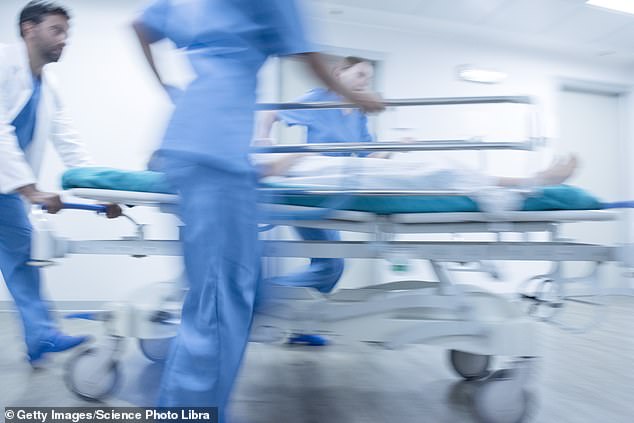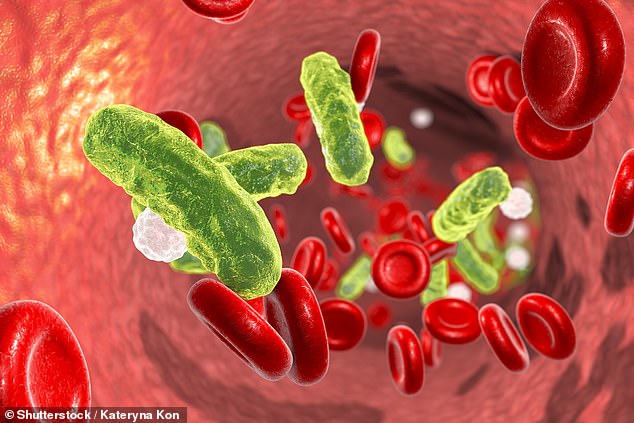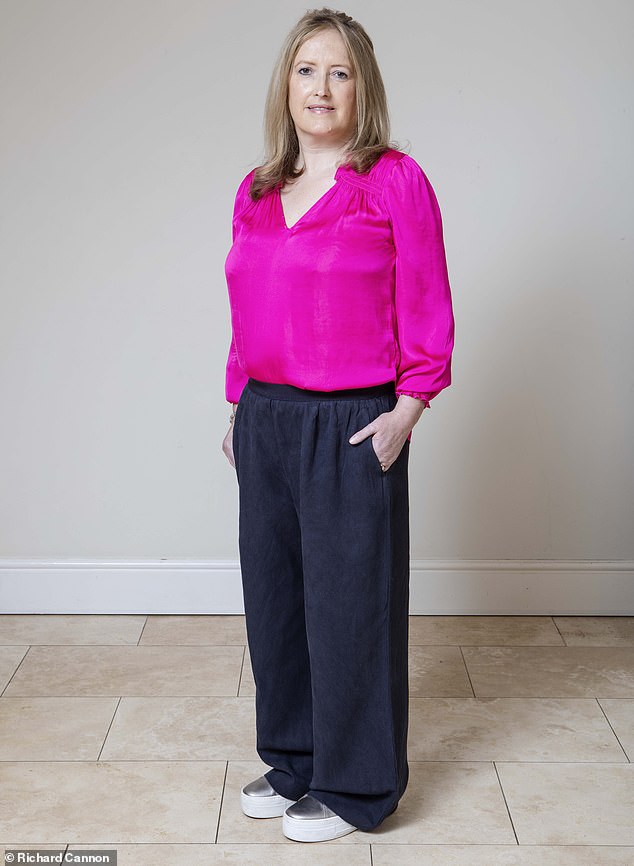The growing crisis of lung sepsis. It leaves patients with fatigue and brain fog – so when will the NHS treat it properly?
Fitness instructor and mother of three Katie Tinkler remembers shouting “Goodbye” to her 16-year-old daughter Isobel as she was carried into an ambulance after she collapsed on the bathroom floor at home on a Saturday morning.
But Katie would not come home later that day, nor return in time to see Isobel through her GCSE exams the following week.
Shortly after being taken to hospital by ambulance, Katie was placed in an induced coma, from which she would not wake for three weeks.
All the while, her life hung in the balance as her body battled the effects of sepsis, a life-threatening condition that occurs when the immune system overreacts to an infection; in Katie’s case, it was pneumonia.
Katie Tinkler was diagnosed with sepsis seven years ago and is still living with the consequences

Super-fit Katie was rushed to hospital where she was placed in an induced coma, from which she would not wake for three weeks
Four days before her collapse, the ‘super-fit’ Katie, who taught 13 fitness classes a week, visited her GP with ‘chills, severe muscle pain and a general feeling of being unwell’.
“The GP told me to go home and drink Lucozade,” she says, and, reassured, she did. It’s advice she would have preferred to ignore.
Not only because she might have avoided three months in hospital, but also because Katie, like thousands of others across the UK, is still suffering from life-changing after-effects known as post-sepsis syndrome seven years later.
The syndrome causes long-term effects that can be physical (from severe fatigue and joint or muscle pain to hair and tooth loss), but also cognitive (such as brain fog and memory problems) and psychological (sleep problems, flashbacks and nightmares are not uncommon).
According to the UK Sepsis Trust, post-sepsis syndrome affects around 40 percent of survivors, or 80,000 people a year. For some people, symptoms last for six to 18 months. Others, like Katie, suffer much longer.
“I’ve become a different person physically and mentally,” she says. “I used to be on the go all the time. I was the life of the party and signed up for every charity triathlon.
“Holidays used to be skiing or coasteering. Now all that has stopped. All I can do is walk, at a slow, frustrating pace for everyone.” She also lives with constant fatigue and bad brain fog.
The UK Sepsis Trust is calling on people suffering from post-sepsis syndrome to access the same kind of rehabilitation as those with long Covid.
Sepsis can have a rapid and devastating impact on anyone, regardless of their condition. “The way one doctor described it to me was like a nuclear bomb of inflammation had gone off in my body,” says Katie.
It was her husband Simon, 53, a management consultant, who called an ambulance when he found Katie unconscious on the bathroom floor of their Surrey home on a Saturday morning in May 2017.
She recalls: ‘In the hospital, I was not expected to survive the day because my organs were shutting down.’
About 245,000 people a year in the UK develop sepsis. It is caused by an infection, usually a chest or urinary tract infection. Babies, the elderly, or people with conditions such as diabetes that make them more susceptible to infection are most at risk.
But “it can affect anyone, it’s completely random,” says Dr Ron Daniels, an intensive care consultant at University Hospitals Birmingham NHS Trust and CEO of The UK Sepsis Trust.
In sepsis, the immune system attacks not only the invading bacteria but also the body’s own tissues, producing chemicals called cytokines that cause widespread inflammation.
If left untreated, it can lead to septic shock, where blood flow to the extremities decreases as the body fights to keep blood flowing to vital organs and blood pressure plummets. In the early stages, it can cause chills and aches “and can be mistaken for the flu,” says Dr. Daniels.
Early detection is essential. Every hour of delay in diagnosis increases the risk of dying from sepsis by one to two percent, estimates The UK Sepsis Trust.
In the UK, five people die from it every hour. However, early treatment with intravenous antibiotics — and fluids to raise blood pressure — can save lives.

Former MP Craig Mackinlay, 57, received a warm welcome when he returned to parliament in May after losing his hands and feet to sepsis last September

The symptoms of post-sepsis syndrome are thought to be due to the after-effects of inflammation and reduced blood flow to certain areas caused by the sepsis.
But the aftermath survivors experience can be life-changing. Former MP Craig Mackinlay, 57, received a warm welcome when he returned to parliament in May after losing his hands and feet after being diagnosed with sepsis last September.
He also suffered tissue damage to his gums, which has caused loose teeth, and to his ears and face.
Craig decided to step down as an MP in part, he said, because “it would be difficult to sustain the 70 to 80-hour working week that was the norm before my illness”.
But post-sepsis syndrome is affecting more and more people, as sepsis becomes more common. This is partly due to an ageing population. But it is also due to the rise of antibiotic-resistant bacteria, which means that infections can linger, making sepsis more likely to strike.
“It is thought that the symptoms of postsepsis syndrome are the result of the after-effects of inflammation and decreased blood flow to certain areas caused by the sepsis,” Dr. Daniels said.
‘For example, reduced blood flow to the hair follicles can lead to hair loss. Sepsis can also be associated with changes in the immune system that last for years, (so) people are at increased risk of infections. That may be because sepsis has an autoimmune element, so the immune system is primed to respond abnormally.’
According to a 2015 study published in the journal Critical Care Medicine, one in three sepsis patients is readmitted to the hospital with an infection within 90 days of discharge.
“Post-sepsis syndrome can be extremely debilitating,” Dr. Daniels says. “The brain fog alone can be severe enough to make it difficult for someone to return to work.” Some people even want post-sepsis syndrome to be called “long sepsis” — to draw attention to how debilitating it can be, he explains.
A review published last year in the journal Infection and Drug Resistance highlighted “many similarities” between the symptoms of post-sepsis syndrome and long Covid. It said: “This raises the question of whether these should be considered separate entities, or whether they represent the same condition.”
But while there are more than 100 clinics in England designated to treat patients with long Covid, staffed by occupational therapists, physiotherapists and specialist nurses, there is no such service for people with post-sepsis syndrome.
Dr. Daniels says, “Usually the best thing that can happen is for a well-meaning nurse to invite patients who have survived sepsis to come in on Saturday morning to tell them how they are doing, but that’s not enough.
“We’ve seen a lot of resources dedicated to people who have survived COVID but have developed long-term problems. But not for those who survive sepsis. It seems unfair that those who survive one virus get the help they need, but those who survive another virus don’t.”
Ideally, there would be similar clinics offering different services for people with postsepsis syndrome, he adds.
Dr Daniels says: ‘It’s a complicated picture because the needs of each individual are different. Some people need counselling, others need physical therapy or dietary advice (because the tissue breakdown that can occur during sepsis means patients need a high-protein diet, for example). But at the moment there’s nothing for them. They’re pretty much on their own.’
After Katie was taken out of her coma — which had reduced her body’s need for oxygen, protecting her organs — she had to learn to talk, eat and walk again. She left the hospital with little ability to care for herself. “I had two visits from the physical therapist at home and that was it,” she says.

Katie left the hospital barely able to care for herself. She had to learn to talk, eat and walk again
Friends raised almost £1,000 to fund 12 private physiotherapy sessions and Simon took three months off work to care for her. ‘For a long time I could only go to school in my pyjamas, without getting out of the car, and had to go straight back to bed when I got home,’ says Katie.
On top of everything else, she has developed heart and kidney problems from the sepsis, which require regular monitoring. She has been hospitalized “about 20 times” since 2017, each time with a different infection. One time last year resulted in the amputation of her pinky finger.
But her biggest fear is getting sepsis again – the risk of which increases slightly once you’ve had it once. ‘Last time I was strong, this time I’m not sure I could fight it,’ she says.
To avoid infections that can cause it, family vacations are usually by car rather than by plane. And friends know not to visit “if they have even a little cold.”
Katie celebrated her 50th birthday with a party and is determined to make the most of what she has. But there is no sugar coating her life. “I have good days and bad days,” she says. “Friends have said that I would happily accept their invitation to a gathering, but I can’t predict whether I’ll be good enough for it.
“When I left the hospital I thought, ‘Great, I don’t have sepsis.’ But after all these years I still suffer from the effects.”
sepsistrust.org
